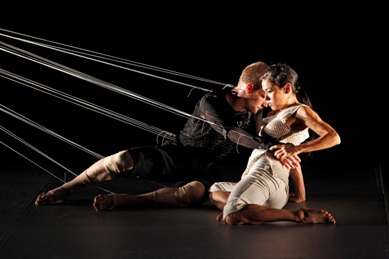MASS MoCA
Chunky Move
March 24, 2012
Review by Anna Rogovoy
(NORTH ADAMS, Mass.) – Australian contemporary dance company Chunky Move appeared at MASS MoCA over this past weekend in Connected, a collaborative work by sculptor Reuben Margolin and choreographer Gideon Obarzanek. Obarzanek, who has been the artistic director of Chunky Move since the company’s inception in 1995, will be replaced by Anouk van Dijk shortly after the North American tour of Connected, making these engagements among the company’s last under his direction. And while it doesn’t have the retrospective or nostalgic feel of a typical “farewell tour”, Connected features many of the central elements of past Obarzanek works (interactive set, dramatic narrative, physically challenging movement), amplified somewhat in intensity.
Margolin’s sculptural set is already onstage when the work begins. As the first dancers power through a series of devastatingly fast movement phrases, often in unison with partners or small groups, other dancers enter the stage and begin to add elements to the sculpture. They are never purely task-oriented (they shift and position their bodies in appealing lines, almost distracting the audience from the dancing happening alongside them), but it’s an interesting juxtaposition: one group of dancers engaged in highly performance-oriented movement, showing off impressive physical prowess, and another group thoroughly engrossed in the subtle process of assembling a sculpture.
The sculpture plays a large role throughout the first half of the work: dancers are attached to cords which manipulate it, imbuing it with the same rippling movement qualities found in Obarzanek’s choreography. One dancer has a “duet” with the sculpture in which it alternates between serving as an extension of her movement and an articulation of the negative space surrounding her.
In this duet, a theme is solidified: the magnification of intimate moments. While the choreography is often large, occupying the dancers’ entire bodies, there is still a striking intimacy to their interactions, a sensual attentiveness to the way that the back of a foot placed against a shin may influence a full undulation of the torso. By blowing up the scale of the movement, Obarzanek allows us to zoom in on small moments; that is, if we don’t miss them. Much of the choreography absolutely shimmers with flurries of activity happening at breakneck speeds. The dancers are formidable.
Connected seems to find its conceptual center after all of the sculpture manipulation and all-out physicality has died down, when each dancer exits and re-enters the stage dressed as a security guard, presumably in an art gallery. The sculpture becomes a static installation as the choreography becomes smaller, more gestural, and sparser. The dancers’ voices, live and recorded, speak monologues about an incident with a stolen work of art. As the tension orchestrated by speed, powerful (and sometimes overpowering) sound, and darkly atmospheric lighting dies down, the audience is given a space in which to contemplate the relationship of the guard to the art; a relationship not entirely unlike the dancer to the dance.
The work seems to be divided into these two striking sections: the intensely physical, abstract first section followed by the more character and narrative-driven second section. The haziness of the work lies in the transition between the two. Are the performers the same “people” in both? They wear different clothing, but are inescapably recognizable. Are the “security guards” referring, metaphorically, to the previous section when they talk about the “work of art”? And more fundamentally, what is taking place onstage (in the movement, lighting, and set) during the transitional moments, and how does it serve to explain what is occurring?
Obarzanek’s wit is clear. He tackles several large themes, multiple design elements, and a diverse range of movement vocabularies. The dancers of Chunky Move are stunning, superhuman. But Connected could be pushed just a bit further to make the connections – pun unavoidable – clearer.
Anna Rogovoy is the Rogovoy Report’s chief dance critic. She studies dance and writing at Bennington College.

